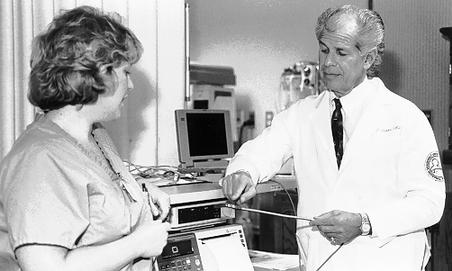New device may curb unneeded Cesareans

Dr. Frank Boehm (right) and research nurse Nancy Townsend examine the new featl monitoring device. (Photo by Donna Marie Jones).
A new fetal monitoring device being tested at Vanderbilt University Medical Center may help reduce the number of unnecessary cesarean sections performed due to concerns over questionable fetal heart rates.
The technique, fetal pulse oximetry, is used in cases of "nonreassuring fetal heart rate tracings," or decelerations in the fetus' heart rate that may ‹ or may not ‹ indicate decreased oxygen delivery or "hypoxia" in the fetus.
"It has the potential to be the most important advance in fetal monitoring in 25 years," said Dr. Frank H. Boehm, professor of Obstetrics and Gynecology.
When using routine electronic fetal heart rate monitoring, it can only be assumed that decelerations in heart rate or changes in heart rate variability are due to poor oxygen saturation, Boehm said. Approximately 5 to 10 percent of c-sections are performed due to these fetal heart rate abnormalities.
About one-third of women in labor have abnormal heart rate tracings.
"It is this 30 percent of women on which unnecessary c-sections are performed," Boehm said. "If the new technique succeeds, the reduction in cesarean sections will be modest, but it will have the very important function of allowing physicians to avoid unnecessary c-sections for questionable fetal monitoring. This particular device has a good shot of helping doctors and nurses know which baby truly is suffering from hypoxia."
Pulse oximetry is not new to medicine. It has been the standard of care in adult and pediatric intensive care units and operating rooms for about a decade. The pulse oximeter, in adults and children, clips on the patient's finger. A red sensor light shines on the finger to read how much oxygen is in the bloodstream. It has been proven safe and effective over the past decade, Boehm said.
The new technology, however, adapts pulse oximetry to a fetus.
VUMC became involved in a pilot study testing the new device last August. The study has now been extended as part of a national, multi-center trial.
Nancy Townsend, a research nurse in Obstetrics/Gynecology, is spearheading the study with Boehm. She said the device has been tested on more than 6,000 babies worldwide, and has not been shown to cause any increase in the incidence of infection or uterine perforation when compared to match controls.
The sterile, single-use, pliable device is inserted into the mother and rests next to the cheek or temple of the fetus during labor.
An adult should have an oxygen saturation level of 99 percent, but a fetus is adequately oxygenated when the level is greater than 30 percent, Townsend said.
The fetal pulse oximeter is only needed when the electronic fetal heart-rate monitor shows deceleration in the fetal heart rate or other non-reassuring signs.
"If we see a reassuring heart rate tracing, or periodic accelerations of the fetal heart rate, I know, based on years of study with fetal heart rate monitors, that this baby is adequately oxygenated," Townsend said. "When we need the fetal pulse oximeter is when there are signs of non-reassuring heart rate status on the heart rate monitor. By using the fetal pulse oximeter we can gain an additional bit of information about the baby. It's exciting because it's non-invasive for the fetus."
The new technology is more reliable than fetal scalp blood sampling, which has been used routinely in some hospitals for years. This new device is internal for the mother but non-invasive for the fetus. While the fetal pulse oximeter gives a continuous real-time monitoring of oxygen saturation reading, fetal scalp blood sampling is an invasive, one-time evaluation which must be repeated each time a level is needed.
Townsend said that during the next year VUMC is expected to enroll 112 women in the randomized fetal pulse oximeter study ‹ half in the test group and half in the control group (those who receive electronic fetal heart rate monitoring alone). Currently, 24 have been enrolled.
Only women whose fetuses show a non-reassuring fetal heart rate will be enrolled in the study.
Cesarean sections result in greater pain to the mother and an increase in infectious morbidity. There is also a risk due to the use of anesthesia. Having a c-section costs three times more than having a vaginal birth and results in longer hospital stays.
They are also still the last resort, Townsend said.
If there is a non-reassuring fetal heart rate status, and the fetus's oxygen saturation is below 30 percent, routine maneuvers are performed to improve the oxygen saturation status, she said. The mother is repositioned and may be given oxygen. If those maneuvers fail to improve oxygen saturation in the fetus, a c-section is performed, she said.
Boehm recently served for two years on a task force which standardized the parameters of fetal heart monitoring.
"We're trying to all speak one language in monitoring," he said. "There are currently many different languages. Doctors use different terms that mean different things to them based on their experience and their education. We're trying to standardize the terminology on a national basis so we all speak the same language."













